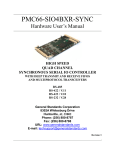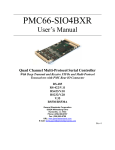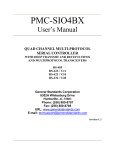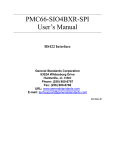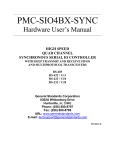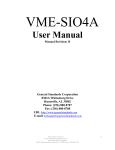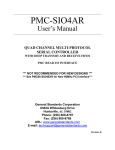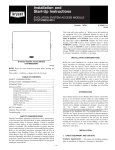Download User Manual - General Standards Corporation
Transcript
SIO4B-FO User’s Manual QUAD CHANNEL RS-485 SERIAL to FIBER OPTIC CONVERTER General Standards Corporation 8302A Whitesburg Drive Huntsville, AL 35802 Phone: (256) 880-8787 Fax: (256) 880-8788 URL: www.generalstandards.com E-mail: [email protected] Revision NR PREFACE Revision History Additional copies of this manual or other General Standards Corporation literature may be obtained from: General Standards Corporation 8302A Whitesburg Drive Huntsville, Alabama 35802 Telephone: (256) 880-8787 Fax: (256) 880-8788 URL: www.generalstandards.com The information in this document is subject to change without notice. General Standards Corporation makes no warranty of any kind with regard to this material, including, but not limited to, the implied warranties of merchantability and fitness for a particular purpose. Although extensive editing and reviews are performed before release to ECO control, General Standards Corporation assumes no responsibility for any errors that may exist in this document. No commitment is made to update or keep current the information contained in this document. General Standards Corporation does not assume any liability arising out of the application or use of any product or circuit described herein, nor is any license conveyed under any patent right of any rights of others. General Standards Corporation assumes no responsibility resulting from omissions or errors in this manual, or from the use of information contained herein. General Standards Corporation reserves the right to make any changes, without notice, to this product to improve reliability, performance, function, or design. All rights reserved No parts of this document may be copied or reproduced in any form or by any means without prior written consent of General Standards Corporation. Copyright © 2007 General Standards Corporation RELATED PUBLICATIONS EIA-422-A – Electrical Characteristics of Balanced Voltage Digital Interface Circuits (EIA order number EIA-RS-422A) EIA-485 – Standard for Electrical Characteristics of Generators and Receivers for Use in Balanced Digital Multipoint Systems (EIA order number EIA-RS-485) EIA Standards and Publications can be purchased from: GLOBAL ENGINEERING DOCUMENTS 15 Inverness Way East Englewood, CO 80112 Phone: (800) 854-7179 http://global.ihs.com/ TABLE OF CONTENTS CHAPTER 1: INTRODUCTION ....................................................................................................................... 1 1.0 1.1 1.1.2 1.1.5 1.1.8 GENERAL DESCRIPTION............................................................................................................................ 1 FUNCTIONAL DESCRIPTION....................................................................................................................... 1 CONTROL LOGIC ................................................................................. ERROR! BOOKMARK NOT DEFINED. RS422/RS485 TRANSCEIVERS .................................................................................................................. 3 CONNECTOR INTERFACE .......................................................................................................................... 3 CHAPTER 2: HARDWARE CONFIGURATION ............................................................................................ 4 5.0 5.2 5.3 5.4 BOARD LAYOUT....................................................................................................................................... 4 INTERFACE CONNECTORS ......................................................................................................................... 5 RS485/RS422 TERMINATION RESISTORS ............................................. ERROR! BOOKMARK NOT DEFINED. JUMPERS CHAPTER 6: ORDERING OPTIONS............................................................................................................. 10 6.0 ORDERING INFORMATION ....................................................................................................................... 10 6.0.2 6.1 6.2 6.3 TRANSCEIVER ........................................................................................................................................ 10 INTERFACE CABLE ................................................................................................................................. 10 DEVICE DRIVERS ................................................................................ ERROR! BOOKMARK NOT DEFINED. CUSTOM APPLICATIONS ...................................................................... ERROR! BOOKMARK NOT DEFINED. CHAPTER 1: INTRODUCTION 1.0 General Description The SI04B-FO Serial to Fiber Optic Converter was designed to convert RS-485/422 signals to Fiber Optic in order to extend their distance. The I/O cable interface was specifically designed to be compatible with General Standards’ SIO4 serial I/O product family but will also work with generic serial I/O. The RS-485 transceivers provide four fully independent synchronous or asynchronous serial channels. Each channel consists of 4 RS485/422 pairs. Features: -pin SCSI-3 connector for serial connections. Adapter cable (SCSI-3 to 4x DB25s) available upon request. 68-pin SCSI-3 connector is compatible with General Standards’ Serial IO Cards such as the XXX-SIO4B/SIO4BX/SIO4BXR and SYNC products. MODE 1: When used with the SIO4BXR-FO board, this makes a complete IO solution. The SIO4BXRFO board provides the PCI host interface, Zilog Z16C30 Universal Serial Controllers (USC), FIFOs and fiber optic transceivers. The Serial to Fiber Optic Converter Box takes the Fiber Optic signals and converts them into standard serial signals as listed below. MODE 2: Boxes can be used, back-to-back to make up a serial to fiber (and then back to serial) extension product. g SIO4BXR boards or any generic serial IO controller product 1.1 Functional Description A functional block diagram of the SIO4B-FO is shown in Figure 1-1. A high density 68-pin SCSI-3 connector is used to connect to the RS485/422 transceivers. The pinouts of this connector are compatible with most of the GSC serial IO products in the SIO4B family. Breakout cables can be used to convert the 68-in connector to DB25s or whatever is desired. RS-485/422 Serial I/O Transceivers RS-485/422 Serial I/O Transceivers FPGA HIGH DENSITY 68-PIN SCSI CONNECTOR SERDES Fiber Optic Transceiver RS-485/422 Serial I/O Transceivers RS-485/422 Serial I/O Transceivers Figure 1-1 Block Diagram of SIO4B-FO Figure 1-2 shows the SIO4B-FO board connected to the PCI-SIO4BXR-FO board. The PCI board provides the PCI host interface, Zilog Z16C30 Universal Serial Controllers (USC), FIFOs and fiber optic transceivers. The fiber optics then interface to the Serial to Fiber Optic Converter Box. This allows for operating many serial channels at high speeds and at long distances. SCSI to DB25 Cable Host Bus SIO4BXR-FO Board Fiber Optic Cables Serial to FO Converter Box Figure 1-2 SIO4B-FO Used with PCI-SIO4BXR-FO Figure 1-3 shows the SIO4B-FO board connected “back to back” to provide for a serial to fiber optic (and back to serial) extension product. This product will be used in this mode when interfacing to existing product in order to extend the distance. PCI-SIO4B User Manual, Revision: E.1 General Standards Corporation 8302A Whitesburg Drive Huntsville, AL 35802, Phone: (256) 880-8787 2 SCSI to DB25 Cable General Standards Serial IO Board SCSI Cable Serial to FO Converter Box Fiber Optic Cables Serial to FO Converter Box Figure 1-3 SIO4B-FO Used “Back to Back” 1.1.5 RS422/RS485 Transceivers Industry standard differential RS485 signaling allows for longer, faster, and more reliable data connections. Socketed termination resistors allow the board to comply with both RS485 and RS422 terminations, or they may be removed for a multi-drop configuration. All RS22/RS485 transceivers are bi-directional, so that any pin may be configured to receive or transmit. This allows the user more flexibility for wiring cable connections 1.1.7 Connector Interface The SIO4B-FO provides a user IO interface through a 68-pin SCSI-3 connector at the face plate. All four serial channels interface through this high-density connector. Signals are grouped at the connector to simplify separating the cable into four distinct serial connectors. Standard cables are available from General Standards in various lengths to adapt the single 68-pin SCSI-3 connector into four DB25 connectors (one per channel). A standard cable is also available with a single 68-pin SCSI-3 connector on one end and open on the other. This allows the user to add a custom connector (or connect to a terminal block). General Standards will also work with customers to fabricate custom cables. Consult factory for details on custom cables. The fiber optic interface is via a standard SFP (Small Form-factor Pluggable) module. This means that the fiber optic transceivers can be swapped out. The standard offering for this product is a multi-mode transceiver which offers moderately long distances. If longer distances are required, single-mode optics can be used. Contact GSC for details. 1.1.8 Power The SIO4B-FO comes with a universal input, 100-240VAC, wall-wart style power supply. This supply provides +5V supply (rated at 3Amps) to the box. PCI-SIO4B User Manual, Revision: E.1 General Standards Corporation 8302A Whitesburg Drive Huntsville, AL 35802, Phone: (256) 880-8787 3 CHAPTER 2: HARDWARE CONFIGURATION 2.0 Board Layout The following figure is a drawing of the physical components of the SIO4B: Figure 2-1: Board Layout PCI-SIO4B User Manual, Revision: E.1 General Standards Corporation 8302A Whitesburg Drive Huntsville, AL 35802, Phone: (256) 880-8787 4 2.1 Interface Connectors The user interface connector on the SIO4B-FO is a SCSI-3 type 68-pin connector (female) mounted to the face plate. The part number for this 68-pin SCSI-3 connector is AMP 787170-7. The mating cable connector is AMP 749621-7 (or AMP 749111-6) or equivalent. The tables below show the pinout for the RS485/RS422 signals if used with the PCI-SIO4BX. The DTE/DCE columns are for the PCI-SIO4BX. This product can also be used with other XXX-SIO4 type products such as the SIO4, SIO4B, SIO4BX, SIO4BXR, etc., and also with the –SYNC products. Keep in mind that if you are interfacing the SIO4BFO box to a PCI-SIO4BX, the RS485 transceivers will be configured in the opposite direction as the PCI board. Any outputs on the SCSI connector on the PCI board will be inputs on the FO box and vice versa. Pin # 1 2 3 4 5 6 7 8 9 10 11 12 13 14 15 16 17 18 19 20 21 22 23 24 25 26 27 28 29 30 31 32 33 34 DTE Signal DCE Signal Ch1 AuxC+ Ch1 AuxCCh1 DCD+ Ch1 DCDCh1 CTS + Ch1 RTS + Ch1 CTS Ch1 RTS Ch1 RxD + Ch1 TxD + Ch1 RxD Ch1 TxD Ch1 RxC + Ch1 TxC + Ch1 RxC Ch1 TxC Ch1 RTS + Ch1 CTS + Ch1 RTS Ch1 CTS Ch1 TxD + Ch1 RxD + Ch1 TxD Ch1 RxD Ch1 TxC + Ch1 RxC + Ch1 TxC Ch1 RxC GND GND GND GND Ch2 CTS + Ch2 RTS + Ch2 CTS Ch2 RTS Ch2 RxD + Ch2 TxD + Ch2 RxD Ch2 TxD Ch2 RxC + Ch2 TxC + Ch2 RxC Ch2 TxC Ch2 RTS + Ch2 CTS + Ch2 RTS Ch2 CTS Ch2 TxD + Ch2 RxD + Ch2 TxD Ch2 RxD Ch2 TxC + Ch2 RxC + Ch2 TxC Ch2 RxC Reserved Spare (1) Reserved Spare (1) Reserved Spare (1) Reserved Spare (1) Pin # 35 36 37 38 39 40 41 42 43 44 45 46 47 48 49 50 51 52 53 54 55 56 57 58 59 60 61 62 63 64 65 66 67 68 DTE Signal DCE Signal Ch3 AuxC+ Ch3 AuxCCh3 DCD+ Ch3 DCDCh3 CTS + Ch3 RTS + Ch3 CTS Ch3 RTS Ch3 RxD + Ch3 TxD + Ch3 RxD Ch3 TxD Ch3 RxC + Ch3 TxC + Ch3 RxC Ch3 TxC Ch3 RTS + Ch3 CTS + Ch3 RTS Ch3 CTS Ch3 TxD + Ch3 RxD + Ch3 TxD Ch3 RxD Ch3 TxC + Ch3 RxC + Ch3 TxC Ch3 RxC GND GND GND GND Ch4 CTS + Ch4 RTS + Ch4 CTS Ch4 RTS Ch4 RxD + Ch4 TxD + Ch4 RxD Ch4 TxD Ch4 RxC + Ch4 TxC + Ch4 RxC Ch4 TxC Ch4 RTS + Ch4 CTS + Ch4 RTS Ch4 CTS Ch4 TxD + Ch4 RxD + Ch4 TxD Ch4 RxD Ch4 TxC + Ch4 RxC + Ch4 TxC Ch4 RxC Reserved Spare (1) Reserved Spare (1) Reserved Spare (1) Reserved Spare (1) Table 2-2: RS485/RS422 Cable Pin-Out NOTE 1: These pins are currently reserved and are not available for use. Please contact the factory with questions about the availability of these pins. PCI-SIO4B User Manual, Revision: E.1 General Standards Corporation 8302A Whitesburg Drive Huntsville, AL 35802, Phone: (256) 880-8787 5 The SIO4B-FO was specifically designed to interface directly with General Standards’ serial I/O products but it can be used in “Back to Back” mode with any serial I/O products as an extension product. The signal names in the table above are for reference only. The user can transmit and/or receive any signals on any pins. The important thing to remember is that the jumpers must be configured properly to get the correct direction (OUT or IN/Transmit or Receive) on the associated differential signal pair. Any of the signals can also be used for discrete I/O as long as they comply with RS485/RS422 standards. PCI-SIO4B User Manual, Revision: E.1 General Standards Corporation 8302A Whitesburg Drive Huntsville, AL 35802, Phone: (256) 880-8787 6 2.2 Board Jumpers The following jumpers are used to configure the direction of the differential signals. J1- Channel 2 J2 – Channel 1 (Shown below) J3 – Channel 4 J4 – Channel 3 J1, J2, J3 and J4 are all identical. J2 1 2 3 4 5 6 7 8 9 10 11 12 13 14 15 16 17 18 19 20 21 22 23 24 CH1 PCI-SIO4B User Manual, Revision: E.1 General Standards Corporation 8302A Whitesburg Drive Huntsville, AL 35802, Phone: (256) 880-8787 7 CHANNEL 1 (J2) Signal SCSI Name Pin# TXD/RXD +/- 7/8 13/14 CTS/RTS +/- 5/6 11/12 TXC/RXC +/- Spare 1A +/Spare 1B +/- 9/10 15/16 1/2 3/4 Direction Jumper IN 3 to 5 AND 2 to 4 OUT IN 9 to 11 AND 8 to 10 OUT 15 to 17 AND 14 to IN 16 OUT 21 to 23 AND 20 to IN 22 OUT Direction OUT IN OUT IN Direction Jumper IN 3 to 5 AND 2 to 4 OUT IN 9 to 11 AND 8 to 10 OUT 15 to 17 AND 14 to IN 16 OUT 21 to 23 AND 20 to IN 22 OUT Direction OUT IN OUT IN Direction Jumper IN 3 to 5 AND 2 to 4 OUT IN 9 to 11 AND 8 to 10 OUT 15 to 17 AND 14 to IN 16 OUT Direction OUT IN OUT IN OUT IN OUT IN Jumper 1 to 3 AND 4 to 6 7 to 9 AND 10 to 12 13 to 15 AND 16 to 18 19 to 21 AND 22 to 24 CHANNEL 2 (J1) Signal SCSI Name Pin# TXD/RXD +/- 21/22 27/28 CTS/RTS +/- 19/20 25/26 TXC/RXC +/- 23/24 29/30 Spare 2A +/Spare 2B +/- 31/32 33/34 OUT IN OUT IN Jumper 1 to 3 AND 4 to 6 7 to 9 AND 10 to 12 13 to 15 AND 16 to 18 19 to 21 AND 22 to 24 CHANNEL 3 (J4) Signal SCSI Name Pin# TXD/RXD +/- 41/42 47/48 CTS/RTS +/- 39/40 45/46 TXC/RXC +/Reserved Reserved 43/44 49/50 35/36 37/38 PCI-SIO4B User Manual, Revision: E.1 General Standards Corporation 8302A Whitesburg Drive Huntsville, AL 35802, Phone: (256) 880-8787 OUT IN Jumper 1 to 3 AND 4 to 6 7 to 9 AND 10 to 12 13 to 15 AND 16 to 18 8 CHANNEL 4 (J3) Signal SCSI Name Pin# TXD/RXD +/- 55/56 61/62 CTS/RTS +/- 53/54 59/60 TXC/RXC +/Reserved Reserved 2.3 57/58 63/64 65/66 67/68 Direction Jumper IN 3 to 5 AND 2 to 4 OUT IN 9 to 11 AND 8 to 10 OUT 15 to 17 AND 14 to IN 16 OUT Direction OUT IN OUT IN OUT IN Jumper 1 to 3 AND 4 to 6 7 to 9 AND 10 to 12 13 to 15 AND 16 to 18 RX485/422 Termination Resistors The RS485/RS422 cable interface requires termination of the differential signals to match the cable impedance. The PCI-SIO4B is shipped with 120 Ohm termination resistor SIPs. These resistors are socketed so they can be changed or removed as necessary. There are eight termination resistors – RP1 through RP8. The termination resistors are standard 8-pin isolated resistor SIPs (four resistors per SIP). Refer to Figure 2.1 for resistor pack locations. 2.4 Front Panel The front panel has the following connections: - Power - SFP Fiber Optic Transceiver - 68-pin SCSI-3 (serial I/O) There following status LEDs are also on the front panel. - LOCK (Green) The LOCK LED indicates that the local Fiber Optic Receiver is locked with a Transmitter. After the Receiver locks, there should be a delay of about a second before the LOCK LED comes on. This is normal. - ERROR (Red) The ERROR LED will be ON if the transceiver loses SYNC for any reason. If the cables are not connected, for instance, the ERROR LED will be on. - TEST (Green) The TEST LED is for factory testing purposes only. This LED should not be on while in the field. PCI-SIO4B User Manual, Revision: E.1 General Standards Corporation 8302A Whitesburg Drive Huntsville, AL 35802, Phone: (256) 880-8787 9 CHAPTER 3: Ordering Options 3.0 Ordering Information 3.0.1 Transceiver The SIO4B-FO uses RS485/RS422 transceivers for the serial I/O interface. The fiber optic interface is via a standard SFP (Small Form-factor Pluggable) module. This means that the fiber optic transceivers can be swapped out. The standard offering for this product is a multi-mode transceiver which offers moderately long distances. If longer distances are required, single-mode optics can be used. Contact GSC for details. 3.1 Interface Cable General Standards Corporation can provide an interface cable for the SIO4B-FO product. This standard cable is a non-shielded, twisted pair ribbon cable for increased noise immunity. Several standard cable lengths are offered, or the cable length can be custom ordered to the user’s needs. Versions of the cable are available with connectors on both ends, or the cable may be ordered with a single connector to allow the user to adapt the other end for a specific application. A standard cable is available which will breakout the serial channels into four DB25 connectors. Shielded cable options are also available. Please consult our sales department for more information on cabling options and pricing. PCI-SIO4B User Manual, Revision: E.1 General Standards Corporation 8302A Whitesburg Drive Huntsville, AL 35802, Phone: (256) 880-8787 10 APPENDIX A: Revision History: PCI-SIO4B User Manual, Revision: E.1 General Standards Corporation 8302A Whitesburg Drive Huntsville, AL 35802, Phone: (256) 880-8787 11















